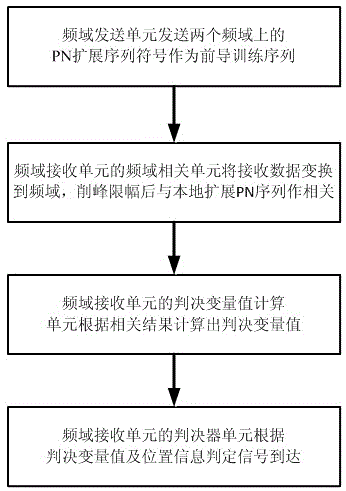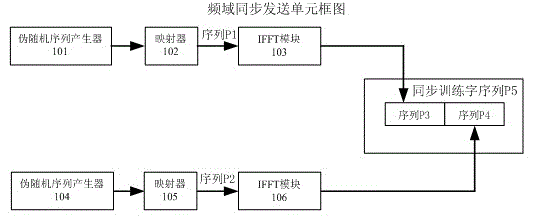Frequency domain arrival detection method of orthogonal frequency division multiplexing system
A technology of orthogonal frequency division and detection method, applied in multi-frequency code system, baseband system components, shaping network in transmitter/receiver, etc., can solve the influence of signal time-domain correlation characteristics, false detection and missed detection probability Improvement, reliability reduction and other issues, to achieve the effect of increased detection success probability, reduced false alarm probability, and reliable signal arrival detection
- Summary
- Abstract
- Description
- Claims
- Application Information
AI Technical Summary
Problems solved by technology
Method used
Image
Examples
Embodiment
[0047] combine figure 2 , the specific steps of the frequency domain synchronization sending unit are:
[0048] 1) First use the pseudo-random sequence generator (101) corresponding to the original polynomial 1 with an order of N to generate a segment with a length of 2 N The PN sequence of -1 is mapped into a bipolar PN sequence with a value of +1 and -1 through the mapper (102), and a 0 is added at the beginning of the sequence to obtain a length of 2 N The sequence P1.
[0049] 2) Then use the pseudo-random sequence generator (104) corresponding to the original polynomial 2 with order N to generate a length of 2 N The PN sequence of -1 is mapped into a bipolar PN sequence with a value of +1 and -1 through the mapper (105), and a 0 is added at the beginning of the sequence to obtain a length of 2 N The sequence P2.
[0050] 3) Send the sequences P1 and P2 into the IFFT modules (103, 106) respectively to obtain the sequences P3 and P4, and then concatenate the sequences ...
PUM
 Login to View More
Login to View More Abstract
Description
Claims
Application Information
 Login to View More
Login to View More - R&D
- Intellectual Property
- Life Sciences
- Materials
- Tech Scout
- Unparalleled Data Quality
- Higher Quality Content
- 60% Fewer Hallucinations
Browse by: Latest US Patents, China's latest patents, Technical Efficacy Thesaurus, Application Domain, Technology Topic, Popular Technical Reports.
© 2025 PatSnap. All rights reserved.Legal|Privacy policy|Modern Slavery Act Transparency Statement|Sitemap|About US| Contact US: help@patsnap.com



